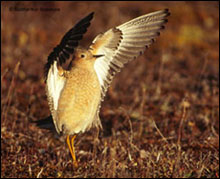wetlands
-
EPA moves to veto wetland-destructive Army Corps project
The U.S. EPA has moved to block an Army Corps of Engineers flood-control project in the Mississippi Delta, the first time the agency has aimed to veto a Corps project since 1990. The $220 million project would have built the world’s largest hydraulic pump, sucking dry enough wetland area to cover New York City in […]
-
The Nation reports on sustainable revitalization of the New Orleans neighborhood
This article by Rebecca Solnit is reprinted from the Sept. 10, 2007 issue of The Nation, released today, which focuses on the aftermath of Hurricane Katrina, two years later. Solnit is the author of a dozen books, including, most recently, Storming the Gates of Paradise: Landscapes for Politics.
-----
The word "will" comes up constantly in the Lower Ninth Ward now; "We Will Rebuild" is spray-painted onto empty houses; "it will happen," one organizer told me. Will itself may achieve the ambitious objective of bringing this destroyed neighborhood back to life, and for many New Orleanians a ferocious determination seems the only alternative to being overwhelmed and becalmed. But the fate of the neighborhood is still up in the air, from the question of whether enough people can and will make it back to the nagging questions of how viable a city and an ecology they will be part of. The majority of houses in this isolated neighborhood are still empty, though about a tenth of the residents are back, some already living in rehabilitated houses, some camped in stark white FEMA trailers outside, some living elsewhere while getting their houses ready. If you measured the Lower Ninth Ward by will, solidarity and dedication, from both residents and far-flung volunteers and nonprofits, it would be among the best neighborhoods in the United States. If you measured it by infrastructure and probabilities, it looks pretty grim. There are more devastated neighborhoods in New Orleans and neighboring St. Bernard Parish, let alone Mississippi and the Delta, but the Lower Ninth got hit hard by Katrina. Its uncertain fate has come to be an indicator for the future of New Orleans and the fate of its African-American majority.
-
On moving to New Orleans, a city defined by water
Wayne Curtis is a freelance writer who’s written for The New York Times, Atlantic Monthly, American Scholar, Preservation, and American Heritage, and is the author of And a Bottle of Rum: A History of the New World in Ten Cocktails. He recently traded Maine winters for New Orleans summers. Thursday, 24 May 2007 NEW ORLEANS, […]
-
Reporter Michael Grunwald gabs about his new book on the Everglades
For about 5,000 years, the waters of the peninsula we now call Florida flowed south into the Kissimmee River. The Kissimmee emptied into enormous Lake Okeechobee, which in turn spilled over into a vast, shallow sheet that slid slowly along the nearly flat expanse of south Florida to the ocean. This was the complex and […]
-
Arctic Refuge drilling debate misses the big picture
Sun-drenched Pelican Island in Florida is about as far from the Arctic National Wildlife Refuge as you can get in the United States. At first blush, the 5,000-acre warm marsh would seem to have little connection to the 19 million-acre stretch of mountains and tundra. But they are inextricably linked. A buff-breasted sandpiper. © Subhankar […]
-
Bush administration floats new plan that would gut wetland protections
It’s close to a nightmare scenario and at the very least it’s a very bad dream.” That’s how Jim Murphy, wetlands and water resources counsel at the National Wildlife Federation*, characterized a draft-stage rewrite of a Clean Water Act rule, which was leaked to The Los Angeles Times by a top government official earlier this […]
-
The Bush administration is jettisoning real scientists in favor of yes-men
Craig Manson. Photo: USFWS. In the final days of October, Craig Manson, assistant Interior secretary for fish and wildlife and parks, dealt a “Godfather”-style blow to a team of government biologists that was about to release a final report with flow recommendations for the Missouri River — a blow that could have a sizable ripple […]
-
An INS project threatens Southern California lands
On a sunny afternoon in Southern California, a Border Patrol agent watched as a man climbed the metal fence that divides the beach between the U.S. and Mexico. When the man dropped onto U.S. sand, the agent yelled, and the man’s friends hauled him back over to the other side of the fence. The fence […]
-
Elizabeth Grossman reviews The Birds of Heaven by Peter Matthiessen
What do Nebraska, Ngorongoro, North Korea, Outer Mongolia, England's Norfolk marshes, and the Australian Outback have in common? The crane -- the elegant, long-legged bird that adorns Asian scrolls, appears on bas reliefs at Angkor Wat and in 6,000-year-old Spanish cave paintings, is reproduced in origami and Chinese bronze, and chronicled by Aboriginal, Ainu and Cree storytellers, as well as by Homer, Virgil, Dante, and Aldo Leopold.


